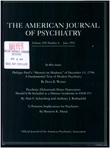Turning points in twentieth-century American psychiatry
Abstract
The author examines four major turning points in twentieth-century American psychiatry, emphasizing the movement during the post-World War II period toward a psychotherapeutic/psychoanalytic approach and the emergence of biological psychiatry, neuroscience, and logical positivism during the 1970s and 1980s. He discusses the impact of Adolf Meyer during the mid-twentieth century and his ongoing influence. The final turning point involves a prediction of a late twentieth-century change, including new directions in nosology, emphasis on combined pharmacotherapeutic/psychotherapeutic treatments, efforts to create alternatives to full inpatient care, better outcome data for psychiatric treatments, and beginning resolution of major boundary problems of current practice.
Access content
To read the fulltext, please use one of the options below to sign in or purchase access.- Personal login
- Institutional Login
- Sign in via OpenAthens
- Register for access
-
Please login/register if you wish to pair your device and check access availability.
Not a subscriber?
PsychiatryOnline subscription options offer access to the DSM-5 library, books, journals, CME, and patient resources. This all-in-one virtual library provides psychiatrists and mental health professionals with key resources for diagnosis, treatment, research, and professional development.
Need more help? PsychiatryOnline Customer Service may be reached by emailing [email protected] or by calling 800-368-5777 (in the U.S.) or 703-907-7322 (outside the U.S.).



